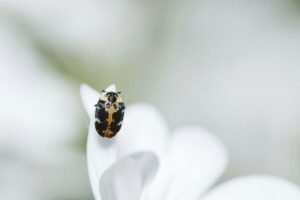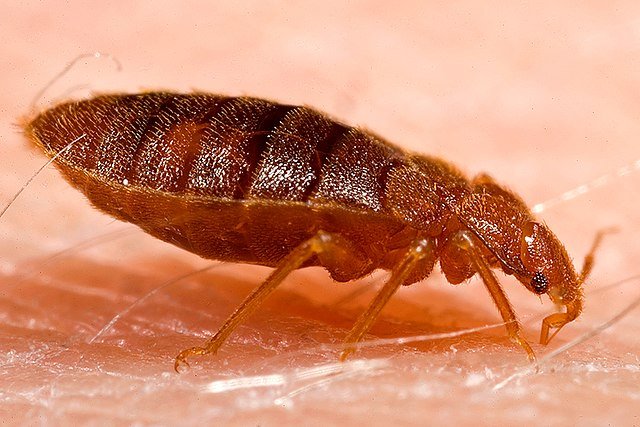Stored‑Product and Household Beetles: Identification, Life Cycle & Control
 Discover how to identify and eliminate common beetles pests infesting stored goods and homes—from flour pests to fabric offenders. Easy prevention tips and professional treatment advice.
Discover how to identify and eliminate common beetles pests infesting stored goods and homes—from flour pests to fabric offenders. Easy prevention tips and professional treatment advice.
1. Introduction: What Are Beetles?
Beetles belong to the order Coleoptera, the largest insect group on Earth. Many species are harmless, but others—especially those known as stored‑product pests—can seriously damage your flour, grains, spices, textiles, and even furniture. In this article, we explore the most common beetle pests, their biology, the damage they cause, and how to effectively control and prevent them.
2. Flour Beetles: Tribolium Species
Tribolium confusum & Tribolium castaneum
Often called flour beetles, these tiny pests thrive in warm, humid conditions and infest flour, cereal, biscuits, pasta, beans, and spice mixes. They are major pests in flour mills.
Key Points:
Do not attack whole, intact grains—but can rapidly multiply in already infested products.
Prefer dark, humid locations like cracks or storage bins.
Eggs are small and white; larvae are beige to light brown, about 9–19 mm long, with two dark projections at the rear.
Thrive in warm places—can produce up to five generations per year.
Adults live from 40 days up to over three years in some cases.
Contaminated grains can have larvae, eggs, and adults living inside crevices, remaining hidden until the next harvest.
3. Sawtooth Grain Beetle: Oryzaephilus surinamensis
Known as the sawtoothed grain beetle, this pest is common in storage facilities for wheat, barley, and rice.
Appearance: Brown, with distinct saw‑tooth projections on the pronotum (behind the head).
Ideal conditions: temperatures of 20–38 °C and relative humidity of 70–90%.
Life cycle: about 15–20 days from egg to adult.
Can rapidly build up large populations in stored grains.
4. Granary & Rice Weevils: Sitophilus Species
The granary weevil (Sitophilus granarius) and the rice weevil (Sitophilus oryzae) are two of the most destructive pests found in stored grains worldwide. These beetles are highly common in grain silos, mills, and storage warehouses—even in cooler climates where other insects may struggle to survive.
Female weevils bore directly into whole kernels and deposit 150–200 eggs, each inside a single grain. The larvae develop entirely within the kernel, feeding unseen until they emerge as adults. Depending on temperature and conditions, they can reproduce up to three generations per year.
The adult lifespan varies:
S. granarius: 12–30 months
S. oryzae: up to 8 months
Adults typically hide deep within grain piles or silos, although they may also appear on bags exposed to sunlight. High humidity combined with weevil activity increases the risk of mold growth, grain clumping, and overall product degradation.
For more detailed biological information, refer to this identification guide on Sitophilus granarius.
5. Biscuit Beetle: Stegobium paniceum
Also known as the biscuit or drugstore beetle, this species infests flour, cereals, spices—and even non-food items like leather, furs, and books.
Adults are 2–3.5 mm, brown, oval-shaped, and capable of flight; attracted to light.
Females lay eggs directly on food packages; larvae feed for months before pupating inside a silk cocoon.
Warm environments can produce up to four generations per year.
Presence is often noticed by tiny holes in packaging.
6. Khapra Beetle: Trogoderma granarium
One of the most destructive stored-product pests, the khapra beetle attacks oily seeds and grains.
Larvae are yellow-brown and hairy, and they can live in cracks for up to 8 years without food.
Optimal development temperature: 21–40 °C.
Can trigger allergic reactions from ingestion or inhalation of larval hairs.
Regulated and quarantined in many countries due to the severe damage they inflict on stored commodities.
7. Tobacco Beetle: Lasioderma sericorne
Also referred to as the cigarette beetle, this pest infests tobacco leaves, but also flour, grains, dried fruits, cookies, spices, and textiles.
Thrives in dry, warm conditions, but can survive at low temperatures for short periods.
Female lifespan: 5–60 days, laying 45–120 eggs about 10 days after reaching adulthood.
Prefers natural fibers—rarely attacks synthetic materials.
Detected by frass (powdery droppings) and small holes in packaging.
8. Garden Escarabs: Phluctinus callosus
Found outdoors and often entering homes, these adults (~7 mm) feed on flowers, buds, foliage, and fruits.
Eggs hatch in 10–14 days during the fall; larvae feed on plant roots through winter and spring.
Adults emerge in October and live about 6 months, mostly active by night and hiding under leaves or bark during the day.
9. Carpet and Fabric Beetles
Several Dermestid species target wool, furs, and natural textiles:
Anthrenus verbasci (varied carpet beetle)
Anthrenus flavipes
Attagenus unicolor
Anthrenus museorum
Traits & Damage:
Larvae are hairy, feed on wool, cotton, feathers, and fur—avoid synthetics.
Life cycle: 50–200 eggs laid in hidden dark corners; larval stage lasts 2 months to 1 year, depending on conditions.
Pupation in a cocoon then quick transformation to adults.
Infested materials often show larvae and their droppings—but adults feed on pollen.
10. Red Palm Weevil: Rhynchophorus ferrugineus
This invasive palm pest—also known as the red palm weevil—is among the most destructive pests for palm trees.
First recorded in Crete (Ηράκλειο) in 2005, likely from Egypt.
Adults: 35 mm long, red‑brown, with a pronounced snout.
Life stages: egg → larva → pupa → adult. Larvae grow up to 50 mm, build tunnels within the tree.
Females lay 200–500 eggs in palm crowns and trunks.
Larvae bore deep tunnels, destroying vascular tissue—visible damage often appears too late.
Adults can fly to neighboring palms, spreading infestation.
Symptoms of Palm Weevil Infestation:
Wilting new leaves and bending older fronds into an “umbrella” shape.
Significant leaf loss and trunk rot—often culminating in tree death.
11. Control & Treatment Strategies
General Steps for All Beetle Types:
Inspection: Identify the species, locate infestation hotspots (dry goods, hidden fabrics, palm trees).
Sanitation: Dispose of heavily infested products; vacuum and clean storage areas thoroughly.
Preventive Exclusion:
Seal cracks, install door sweeps, and maintain good sealing on silos/storage units.
Chemical Treatment:
Insecticides applied as residual sprays on shelves/cabinets (for stored food pests) or as soil drench or trunk injections for trees.
Use fumigation, fogging, or insecticidal dusts per professional guidelines.
Monitoring & Trapping:
Sticky traps or pheromone traps help detect hidden pests (e.g. weevils, fabric beetles).
Thermal and Washing Treatments:
Launder infested fabrics at 60 °C.
Heat treatments for flour or cannabinoid‑infested grain.
Professional Pest Control:
A licensed technician will perform thorough inspection, apply approved biocides, and provide post‑treatment prevention advice.
Specific Tips:
For flour and cereal weevils, freeze products for 4 days at –18 °C to kill larvae and eggs.
For textile pests, vacuum and clean wardrobes monthly, especially at seams and folds.
For red palm weevil, remove and destroy severely infested palms by burning, then treat nearby palms immediately with trunk injectables and pheromone traps. Avoid moving palms from infested areas and prune only outside the active flight period (December–February).
12. Prevention Guide
| Area | Action |
|---|---|
| Pantry | Store grains in airtight containers |
| Hygiene | Clean all storage surfaces regularly |
| Inspection | Check packaging for holes, frass |
| Environment | Maintain low humidity, adequate airflow |
| Monitoring | Use traps in grain silos, cabinets |
| Textiles | Shake/freeze or wash stored textiles |
| Outdoors | Inspect palms; trim, disinfect early infestations |
Effective prevention starts with cleanliness, exclusion, and constant monitoring.
13. Why It Matters for Your Business
Whether you're a homeowner, restaurant owner, farmer, or warehouse manager, understanding and managing beetle pests is vital for product safety, hygiene, and reputation. Modern pest control also plays a key role in compliance with food safety standards like HACCP and in avoiding costly losses.
14. Frequently Asked Questions (FAQ)
Q1: Can fabric beetles survive on synthetic clothing?
A1: No—they feed only on natural fibers containing protein like wool, cotton, silk, feathers, and animal skins.
Q2: How do I know if my grains are infested by weevils?
A2: Look for tiny entry holes in the kernels, fine dust, and beetle adults crawling or emerging in food.
Q3: Can heat or cold kill stored‑product beetles?
A3: Yes—freezing at –18 °C for 4 days or heating grains above 60 °C for several hours is effective against larvae and eggs.
Q4: Is fumigation necessary for the khapra beetle?
A4: Often yes—it’s a serious quarantine pest. Always contact certified professionals and local agricultural authorities.
Q5: What first steps should I take for red palm weevil infestation?
A5: Identify and destroy heavily infested palms, then treat remaining trees with injectables, trunk sprays, and pheromone traps. Avoid moving plant material in or out of infested areas.
15. Final Thoughts
Beetles of stored products and fabrics pose a serious challenge—but with proper identification, cleaning, storage methods, monitoring, and professional treatment when needed, you can protect your goods, home, and business effectively.
For help with chemical treatments or specialized pests (like red palm weevil), always hire a certified pest control technician who follows legal regulations and uses approved products.
Ready for More Pest Control Insights?
To learn more about flies, ants, cockroaches, bed bugs, and other pests—and how to protect your home or business effectively—visit our main blog page.
Disclaimer: This article is for informational purposes only. Pest control regulations and approved treatments vary by country. For legal compliance and safety, consult a licensed pest control professional. Always ensure correct identification of insects and use products as instructed by the label or local authority guidelines.

